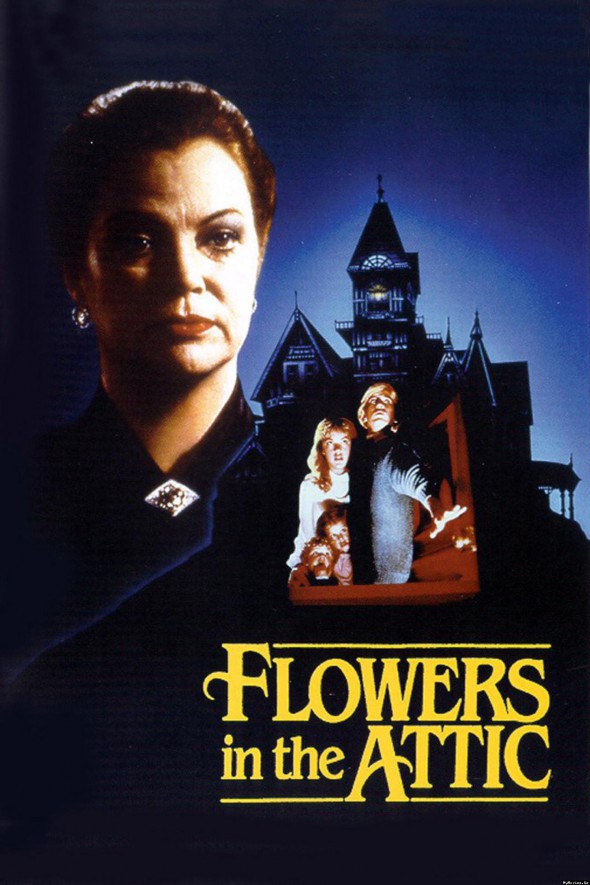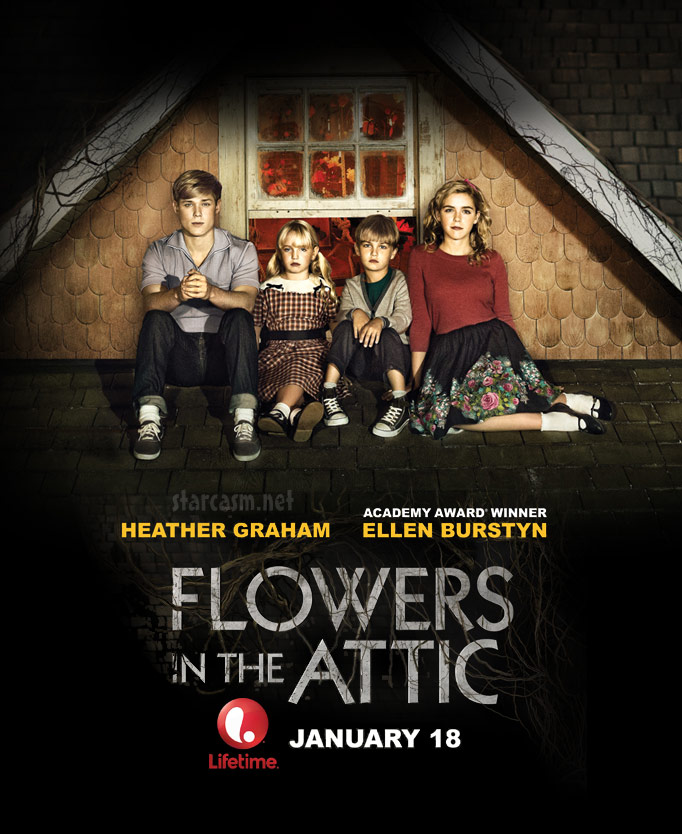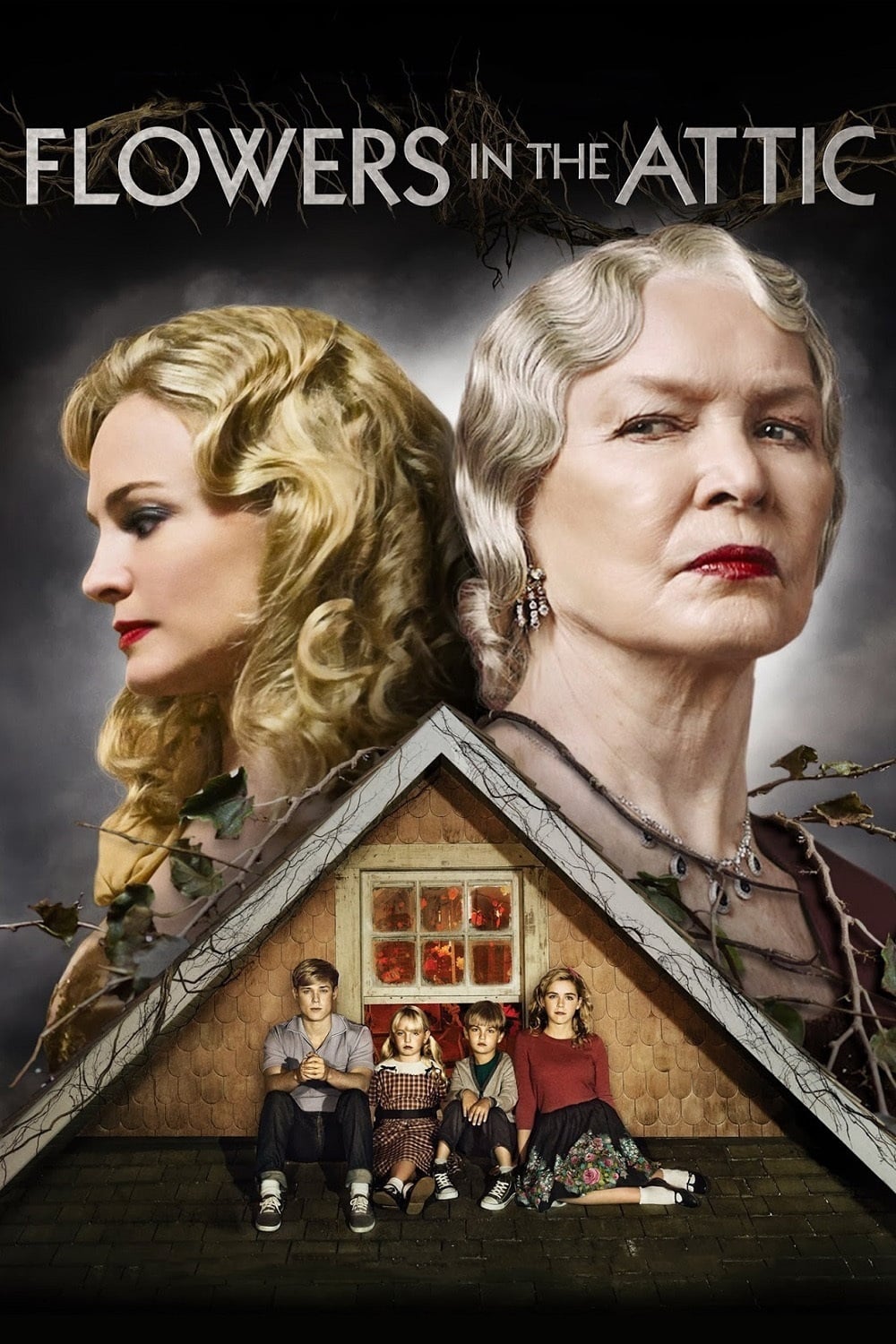Unveiling The Timeless Allure Of "Flowers In The Attic": A Cinematic Masterpiece Beyond Genre
Does a film truly transcend its genre, leaving an indelible mark on the collective consciousness? "Flowers in the Attic," more than just a cinematic adaptation, stands as a stark and unsettling exploration of family secrets, betrayal, and the corrosive impact of isolation. Adapted from V.C. Andrews' provocative novel, the 1987 film adaptation has captivated audiences for decades, weaving a narrative of such intensity that it continues to spark debate and intrigue.
The story of the Dollanganger family unfolds with the deceptive promise of idyllic normalcy. After a sudden and devastating tragedy, the mother, Corrine, and her four children—Cathy, Chris, and the twins, Carrie and Corey—are thrust into a maelstrom of secrets and confinement. As the children navigate the treacherous landscape of their new reality, audiences are drawn into a suspenseful drama that explores the very essence of familial relationships and the depths of human resilience. This piece offers a detailed examination of the film’s intricate plot, its memorable characters, and the profound cultural impact that has solidified its place in cinematic history.
| Biographical Data | Details |
|---|---|
| Full Name | Virginia Cleo Andrews |
| Birth Date | June 6, 1923 |
| Birth Place | Portsmouth, Virginia, USA |
| Pen Name | V.C. Andrews |
| Death Date | September 19, 1986 |
| Occupation | Author |
| Notable Works | Flowers in the Attic (1979), Petals on the Wind (1980), If There Be Thorns (1981), My Sweet Audrina (1982), Seeds of Yesterday (1984) |
| Genre | Gothic Fiction, Family Saga, Young Adult |
| Legacy | Best-selling author; her novels, particularly the "Dollanganger Series," have sold millions of copies and have been adapted into successful films. |
| Reference | Encyclopedia Britannica - V.C. Andrews |
Understanding the genesis of "Flowers in the Attic" is crucial to appreciating its enduring appeal. The novel, published in 1979, quickly became a literary phenomenon, captivating readers with its gothic themes and unflinching portrayal of taboo subjects. The film adaptation, released in 1987, capitalized on this success, bringing the story to a wider audience and generating widespread discussion. This article delves into the key elements that have contributed to the film's lasting legacy, from its complex characters to its exploration of uncomfortable truths.
- Layne Funeral Home Cremation Services Info Obituaries
- November 28 Zodiac Sagittarius Traits Astrology Insights
The narrative begins with the seemingly perfect life of the Dollanganger family. Their idyllic existence is abruptly shattered by the sudden death of the father, James. This tragic event forces Corinne to return to her family's opulent, but ultimately unforgiving, mansion. The children, Cathy, Chris, Carrie, and Cory, are initially hopeful about their new surroundings, but their optimism is swiftly crushed. They soon discover that their presence is not welcomed by their wealthy and deeply religious grandparents, Olivia and Christopher Sr. The children are then cruelly confined to a secluded attic, a space that becomes a stark symbol of their isolation and the family's dark secrets.
As the story unfolds, the attic becomes a prison, both physical and psychological. The children must confront the harsh realities of their situation, enduring physical deprivation, emotional manipulation, and the constant threat of exposure. The attic's close quarters breed tension, exacerbating the existing family dynamics and the burgeoning relationships between the siblings. The narrative intricately explores the themes of love, betrayal, and survival as the children desperately attempt to escape their grim circumstances and the web of deceit that enmeshes them.
The film's power lies not only in its plot but also in its complex and multifaceted characters. Each character's actions and motivations propel the story forward, contributing to the film's overall impact. The characters are not simply archetypes; they are flawed, vulnerable, and deeply affected by their circumstances. Understanding their individual journeys is crucial to appreciating the film's themes and messages.
- Leo Woman Cancer Man Love Compatibility Challenges
- Dutton Family Tree Unraveling The Yellowstone Saga From 1883 To Today
Cathy is the heart of the story, the protagonist whose perspective guides the audience through the film's turbulent events. As the eldest daughter, Cathy embodies resilience and determination. Her journey from innocence to despair is central to the narrative, and her struggles to protect her siblings while grappling with betrayal and loss are both heartbreaking and compelling. She is the anchor, the one who fights for survival and, later, for vengeance. Cathy's growth, or rather, her forced maturation, is a crucial element of the film's commentary on the loss of childhood and the corrupting influence of abuse and neglect. Her choices, driven by a mixture of love, loyalty, and a desperate desire for freedom, shape the fate of the entire family.
Chris, Cathy's brother, represents the protector and the moral compass of the family. His relationship with Cathy, though complicated by their circumstances, becomes a focal point of the story, challenging societal norms and exploring the limits of familial bonds. Chris's loyalty to his siblings is unwavering, even as they face horrific conditions. He provides a sense of stability amidst the chaos. His struggle to maintain his sense of self and protect his sister from the depravity around them is a key element in the narrative's emotional impact. He is not just a brother; he is a caregiver, a confidant, and a source of unwavering support.
Corinne is the film's tragic figure, the mother whose choices set the entire tragic chain of events in motion. Driven by her desire for her father's inheritance and approval, she makes a series of devastating decisions that seal the fate of her children. Her internal conflicts and the relentless pressure she faces from her parents highlight the theme of societal expectations and the consequences of prioritizing wealth and status over family. Corinne's descent into despair and her eventual moral bankruptcy serve as a cautionary tale about the corrosive effects of greed and ambition. She represents the broken promises, the shattered dreams, and the devastating consequences of prioritizing societal expectations above the well-being of her own children.
The grandparents, Olivia and Christopher Sr., serve as the primary antagonists, representing the rigid societal norms and religious hypocrisy that contribute to the children's suffering. Their cruelty is driven by religious fanaticism and a desperate desire to maintain their family's reputation. Olivia's actions are particularly disturbing, as she becomes complicit in the children's confinement and abuse. Christopher Sr. represents the cold, calculating patriarch who is more concerned with his legacy than the well-being of his grandchildren. They embody the forces of repression and control that the children must overcome in their quest for survival. They stand as symbols of the destructive power of secrets and the devastating impact of religious dogma when combined with a lack of empathy.
The exploration of themes within "Flowers in the Attic" is what elevates the film from mere melodrama to a compelling and thought-provoking piece of cinema. These themes resonate with audiences long after the credits roll, prompting reflection on the nature of family, the impact of trauma, and the importance of resilience.
Isolation is a central theme in the film, vividly portraying the profound psychological and emotional toll it exacts. The children's confinement in the attic is not merely physical; it is a form of sensory deprivation that fuels their despair and desperation. The lack of social interaction, the constant threat, and the uncertainty of their future create an environment ripe for psychological breakdown. The film explores the devastating impact of isolation on mental health, highlighting how it can erode one's sense of self and ability to cope with adversity.
The film delves into the complex and often fraught nature of family relationships. It showcases the love, betrayal, and struggle for acceptance that can exist within a family unit. The Dollanganger family exemplifies the extremes of these dynamics, from the intense bonds between siblings to the destructive influence of parental expectations and the corrosive effects of secrets. The film underscores the importance of healthy family relationships and the damage that can be inflicted by dysfunction.
"Flowers in the Attic" is, at its heart, a story of survival. The children's fight to endure the horrific conditions they face is a testament to the resilience of the human spirit. They are forced to make difficult choices and to rely on each other to stay alive. The film highlights the lengths to which people will go to protect themselves and their loved ones in the face of adversity. Their resilience is a constant struggle, an ongoing battle against the forces seeking to destroy them.
The film illustrates how secrets, particularly those hidden within a family, can have devastating consequences. The Dollanganger family's secrets—incest, illegitimate births, and hidden motivations—create a web of deceit that leads to tragedy. The film serves as a cautionary tale, highlighting the destructive power of secrets and the importance of honesty and transparency in interpersonal relationships. The lies erode trust and create a climate of fear and suspicion, ultimately leading to the family's downfall.
The film's impact on popular culture cannot be overstated. The 1987 release of "Flowers in the Attic" was a cultural touchstone, sparking a wave of discussion about taboo subjects and prompting conversations about the dark undercurrents of family life. Its controversial themes, including child abuse, incest, and family dysfunction, struck a nerve with audiences, leading to a devoted cult following. The film broke boundaries by addressing subjects that were considered off-limits in mainstream cinema, forcing viewers to confront uncomfortable truths about the world.
Critically, the film received mixed reviews. Some critics praised its dramatic elements, the performances, and the adaptation of the novel, while others were critical of its handling of the source material, especially the darker and more disturbing aspects. It has maintained a prominent place in popular culture, influencing subsequent adaptations and inspiring discussions about its themes and its place in the canon of classic films.
The enduring appeal of "Flowers in the Attic" has led to various adaptations over the years, each offering a unique interpretation of V.C. Andrews' original work. These adaptations have introduced the story to new audiences while sparking renewed interest in the source material. The critical reception of "Flowers in the Attic" was varied, reflecting the divisive nature of the source material. While some critics praised the performances, the visual style, and the adaptation's dramatic elements, others felt the film glossed over the darker aspects of the story, particularly the elements of incest and abuse.
Despite the varied opinions, the film's ability to provoke thought and discussion has become its most significant legacy. It sparked conversations about difficult subjects that had previously been largely absent from mainstream cinema. The film's rating on Rotten Tomatoes, a well-known review aggregator, reflects the mixed opinions of critics and audiences. The wide range of opinions highlights the controversy surrounding the subject matter, and the film continues to be a subject of debate among film scholars and enthusiasts.
The themes of "Flowers in the Attic" resonate with broader societal trends. In an era where discussions about trauma, mental health, and family dysfunction are increasingly prominent, the film's exploration of these issues remains relevant. Celebrities and public figures have also engaged with these themes, bringing them into the mainstream conversation. For instance, the rise of memoirs and documentaries addressing familial abuse and dysfunction reflects the enduring relevance of the themes explored in "Flowers in the Attic." The film's impact extends beyond cinema, influencing literature, television, and even music, as artists continue to grapple with the complexities of family and identity.
Ultimately, "Flowers in the Attic" is more than a film; it is a cultural artifact that continues to captivate and challenge audiences. Its exploration of taboo subjects, its complex characters, and its enduring legacy ensure its place in the annals of cinematic history. As society continues to grapple with the dark undercurrents of family life, the film's message remains as powerful and resonant as ever.
- Discover Christian Tattoo Designs Ideas Inspiration For Your Ink
- Erik Menendezs Daughter Talia Wife Tammi Where Are They Now

Flowers in the Attic 1987 s Download movie

Is Flowers in the Attic based on a true story?

Flowers in the Attic (2014) Posters — The Movie Database (TMDB)